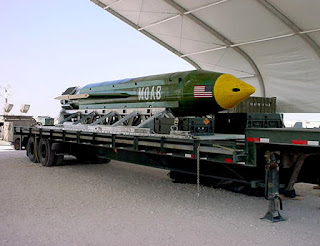The United States dropped “the mother of all bombs,” the largest non-nuclear device it has ever unleashed in combat, on a network of caves and tunnels used by Islamic State in eastern Afghanistan on Thursday, the military said.
President Donald Trump touted the bombing as evidence of a more muscular US foreign policy since he took office in January after eight years of President Barack Obama.
The 21,600 pound (9,797 kg) GBU-43 bomb was dropped from a MC-130 aircraft in the Achin district of Nangarhar province, close to the border with Pakistan, Pentagon spokesman Adam Stump said.
The GBU-43, also known as the “mother of all bombs,” is a GPS-guided munition and was first tested in March 2003. It is regarded as particularly effective against clusters of targets on or just underneath the ground.
It was the first time the United States has used this size of conventional bomb in a conflict.
Trump described the bombing as a “very successful mission.” It was not immediately clear how much damage the device did.
During last year’s presidential election campaign, Trump vowed to give priority to destroying Islamic State, which operates mostly in Syria and Iraq. He flexed US military muscles last week by ordering a cruise missile attack on a Syrian government airbase in retaliation for a poison gas attack.
“If you look at what’s happened over the last eight weeks and compare that really to what’s happened over the last eight years, you’ll see that there’s a tremendous difference,” Trump told reporters at the White House on Thursday.
The security situation remains precarious in Afghanistan, with a number of militant groups trying to claim territory more than 15 years after the US invasion which toppled the Taliban government.
So far, Trump has offered little clarity about a broader strategy for Afghanistan, where some 8,400 US troops remain.
SPECIALISED WEAPON
Last week, a US soldier was killed in the same district as where the bomb was dropped while he was conducting operations against Islamic State.
White House spokesman Sean Spicer said the bombing “targeted a system of tunnels and caves that ISIS fighters used to move around freely, making it easier for them to target US military advisers and Afghan forces in the area.”
Spicer said the bomb was dropped at around 7 pm local time and described it as “a large, powerful and accurately delivered weapon.” US forces took “all precautions necessary to prevent civilian casualties and collateral damage,” he said.
Foreign policy experts said that it appeared the use of such a specialized weapon had more to do with the type of target – tunnels – than the United States sending any message to other countries by using such a powerful weapon.
“This is a very specialised weapon, we don’t have very many of them, you can only use them in a very narrow set of circumstances,” said Mark Cancian, a senior adviser with the Centre for Strategic and International Studies think tank.
Cancian added that while sending a message to Syria or North Korea could have been among the secondary factors considered, they would not have been the main reason for using this type of weapon.
The top US commander in Afghanistan said recently that he needed several thousand more international troops in order to break a stalemate in the long war with Taliban insurgents.
US officials say intelligence suggests Islamic State is based overwhelmingly in Nangarhar and neighbouring Kunar province.
Estimates of its strength in Afghanistan vary. US officials have said they believe the movement has only 700 fighters but Afghan officials estimate it has about 1,500.
The Afghan Taliban, which is trying to overthrow the US-backed government in Kabul, are fiercely opposed to Islamic State and the two group have clashed as they seek to expand territory and influence.

No comments:
Post a Comment